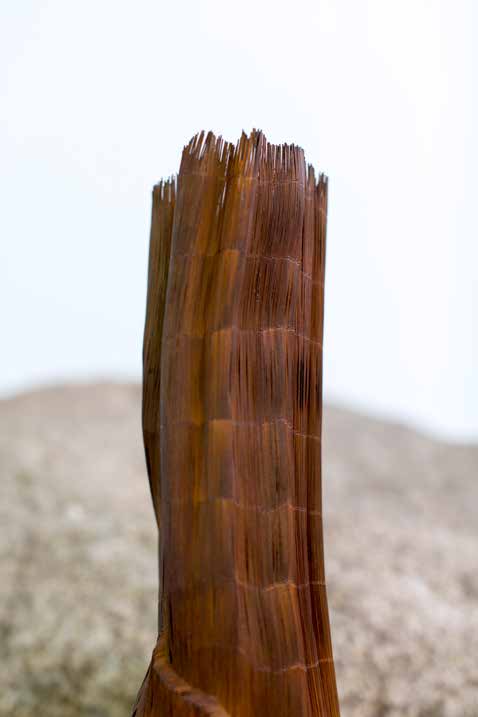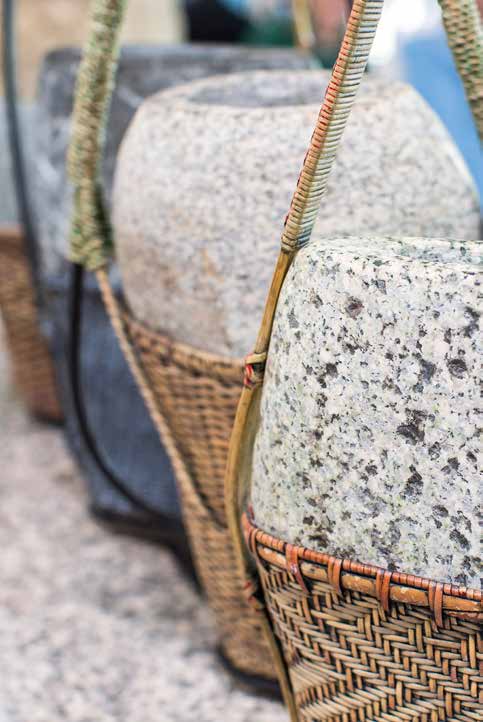Everything
The future of handicrafts will be separated from tradition, despite who influences it. It will recognise those indescribable grey areas that distance it from what we know as art. And, finally, it will see a new appreciation for trades that charge a new use in these times of galloping dematerialisation. That was the feeling one got at Loewe’s annual Foundation Craft Prize held in Tokyo.
![]()
“The paradox is that the digital era brings us closer to crafts,” says Jonathan Anderson, creative director of Loewe since 2013, in the lobby of a distressed diaphanous hotel in downtown Tokyo. “We live locked in non-tactile realities. We have forgotten that handicraft is part of who we are, that it lies inside each person as a kind of instinct.” Anderson, looking exhausted and somewhat haggard, ended three days devoted to the Loewe Foundation Craft Prize, which he devised three years ago to reward the best crafts with artistic ambition from all over the world. When he had the idea of creating an award, back in 2016, he could have dedicated it to contemporary art, whose synergies with luxury groups have already become common place. But he preferred to devote his efforts to a discipline he has collected for a decade.
“Contemporary art already has enough props,” says Anderson. “The opposite is true with crafts: it is flagrant that you have to lend a hand.” Not everyone understood, but that is what happens when you have a pioneering vocation. “I have always believed that it is better to get to the party first than last,”
he jokes.
The rebound of the trades industry coincides, according to the designer, with an awareness. Just as a long-distance conversation will never replace the pleasure of sharing a coffee with a friend, a virtual interface cannot match that indescribable aura that has everything original. “We are consumed by digital life, which is more loud and exaggerated than real life,” he says. “Every day, I observe a stronger disconnection with respect to that reality. It’s as if we find it hard to know how to behave.” His prize is, in the end, a call to remind us.
![]()
Among the 29 finalist works (there were more than 2500 applicants, almost double that of 2018), there were abstract ceramics and gold mandalas; brutalist sculptures and wickerwork made from newspaper; delicate goldsmiths and stark textile works. They were united by the will to explore the future of the discipline that wants to separate itself from the strong rules of the past. “We are interested in everything that indicates paths to the future and questions the above,” says Anatxu Zabalbeascoa, the president of the jury and critic of architecture and design at Spanish newspaper El País. For Zabalbeascoa, the new place that crafts occupy responds to that gradual disappearance of objects. “But also to the change of direction that art has taken, which has neglected beauty and pleasure in assuming other objectives, such as the claim,” she says. “That has left a place for crafts, which is a form of expression that everyone can understand.”
The relatively affordable cost of the pieces, if we compare it with the stratospheric sums paid for the smallest work of art, have caused collectors and gallery owners to occupy a still semi-virgin land, as evidenced by the success of fairs such as Collect, in London, or Talente, in Munich. Also, the luxury firms move file: the LVMH group, to which Loewe belongs, will open a new museum in Paris next year dedicated to the so-called métiers d’art. That is to say, everything that is situated between handicrafts and art, such as ceramics, jewellery, goldsmithing, textile creation and traditional leather goods, with which Loewe opened as a brand in 1846. The rest of the members of the international jury, which included a stellar selection of names in architecture and design, agreed on that diagnosis. “At a time when everything is going at an unprecedented speed, and inventions such as the iPhone, Airbnb and Tinder have changed, in just a few years, our way of life, craftsmanship points to other values,” says Deyan Sudjic, director of the London Design Museum.
![]()
In that sense, discipline works almost like an instrument of dissent. “It is ironic to think that something so traditional can be subversive, but that is what happens at a time when everything becomes dematerialised. We return to objects to reflect on who we are.” The craft prize serves to publicise artistic practices subject to a certain invisibility towards the public, like walking between two waters. “They are creators who have few spaces to exhibit, because they are located in an imprecise place between what is considered art and what is not,” says designer Naoto Fukasawa, director of the Folk and Crafts Museum in Tokyo. Even in Japan, idealised from the Western world as a paradise for artisans, the situation is difficult for anyone who tries to . innovate with respect to tradition. In his workshop school in the Aoyama neighborhood, goldsmith Koichi Io, 32, recognised that almost all of his market is in Europe and the United States. “In Japan, I have only sold a couple of pieces,” he admits, standing next to a recent work, a giant molar vessel in patinated and reddish copper. The key, according to Fukasawa, is that “in Japanese culture, tradition is very important and artisans simply follow it. They think there is no other way to do things.”
The Loewe ceremony took place in Sogetsu Kaikan, a building designed by architect Kenzõ Tange (winner of the Pritzker Prize in 1987), which is attached to the imperial palace of Akasaka, where the works were exhibited in the spectacular stone garden by another famous Japanese architect, Isamu Noguchi. Surface Tactility #11, the winning piece, stood out among its rivals: a small sculpture of mysterious contours in carmine colour, the work of 37 year-old Genta Ishizuka from Kyoto. The craftsman, son of a manufacturer of traditional furniture, had the idea in a supermarket after discovering a mesh bag full of oranges. He used styrene balls to simulate a similar shape, which he then covered for weeks with a daily layer of lacquer, following the ancient technique of urushi, which some date to the seventh century.
“Actually, the method is not important,” says Ishizuka. “What matters is to feel the beauty of the material. In that sense, I feel more an artist than craftsman, because I don’t focus on technique or tradition. And also because I don’t obey anyone’s rules.” Ishikuza, shy and persistent, smiling and untidy, became the perfect ambassador for this award, endowed with 50,000 euros (AUD$80,000), which he will use to open a new workshop.
![]()
On an upper floor of the building, which on weekdays is occupied by an Ikebana school, a Milanese Asturian, the designer Patricia Urquiola, and a Catalan Milanese, the architect Benedetta Tagliabue, debate the award decision moments later. “He has applied that red lacquer, an extremely traditional technique, to a form as banal as a bag of oranges,” says Tagliabue to justify the election of the jury. “If you saw it in an archeological museum, it would seem like a primitive object. It is futuristic and ancestral at the same time.”
Both agree that Loewe is doing a great job of spreading awareness of handicrafts. “They have the generosity to make it clear that they not only want to sell dresses, but also educate, spread other values and reward those who connect the head with the hand,” adds Tagliabue. Urquiola, on the other hand, would like to witness these techniques in Spain, where the delay in her recognition is noticeable. “I always say that there is much to rediscover,” she says.
It sounds like a happy threat.
Words: Álex Vicente
Photography: Audoin Desforges/Pasco&Co
THIS ARTICLE WAS ORIGINALLY PUBLISHED IN THE OCTOBER 2019 EDITION OF ICON AUSTRALIA.
RECEIVE YOUR ISSUE HERE.

